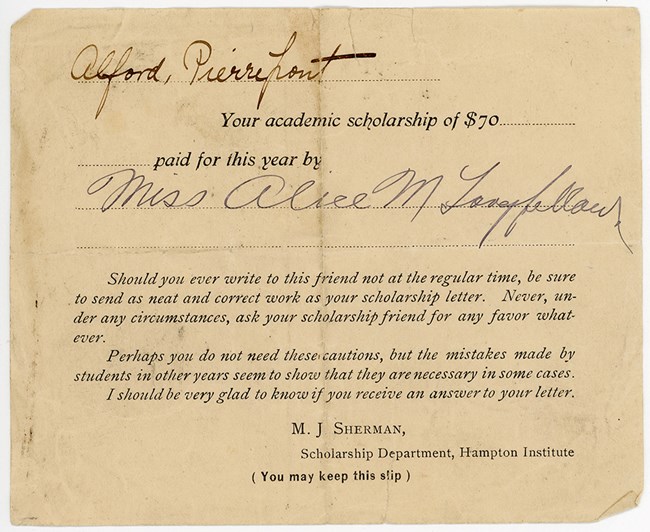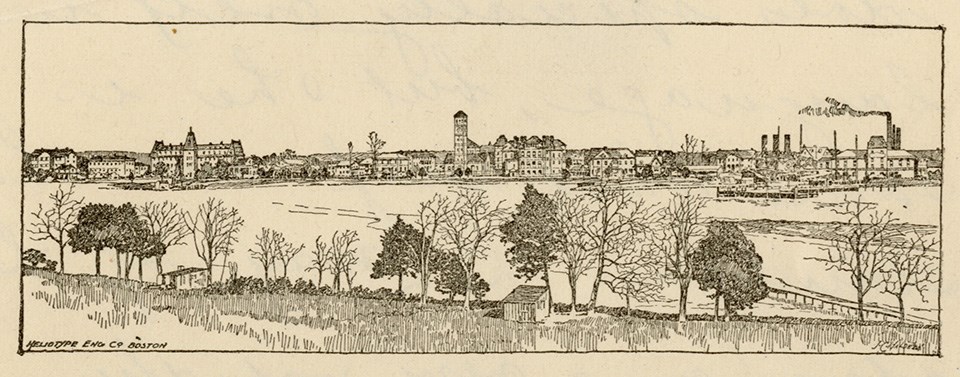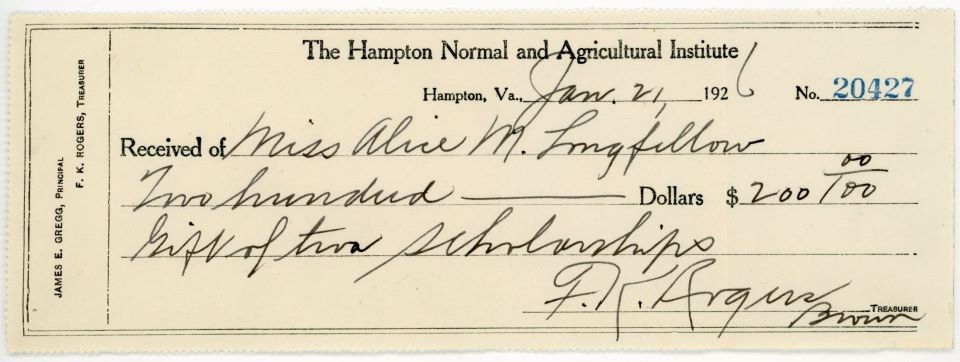Last updated: March 24, 2023
Article
“More Precious Than Rubies”: Alice Longfellow and Students at Hampton & Tuskegee Institutes
The post-Reconstruction period was a defining time for the country as the Civil War and abolition of slavery redefined the structure of society. Many Historically Black Colleges and Universities - like Tuskegee University in Alabama and Hampton University in Virginia - were founded during this period as institutes for educating teachers and providing technical training. The leaders of Hampton and Tuskegee Institutes, Samuel C. Armstrong and Booker T. Washington, worked tirelessly to develop skilled tradespeople in crafts such as carpentry, farming, dressmaking, bricklaying and brickmaking, machine shop, and foundry. National events spurred Armstrong and Washington to develop a strong commitment to educating and training young Black men and women.
“I have such a friend whom I have never seen”
Dear Miss Longfellow:
This duty of writing to you, what we call, “a scholarship Letter," is a source of great pleasure to me.
Please accept my most sincere thanks for having paid my scholarship for this year. It means a great deal to me to feel and to know that I have such a friend whom I have never seen.
- Coatney Arrington, 27 February 19081

Alice Mary Longfellow Papers, Longfellow House-Washington's Headquarters NHS.
From 1883 to 1926, Alice Longfellow made donations toward academic scholarships at both Hampton Institute and Tuskegee Institute. Today, 108 letters from students and administrators are preserved in the Alice Mary Longfellow Papers in her Cambridge home, now Longfellow House-Washington's Headquarters National Historic Site. Following guidance from the administrators, 23 Black students dutifully wrote Alice Longfellow letters thanking her for sponsorship. Within these letters, the students mainly described the conditions and rigor of their experiences at their respective schools. Some students also provided a glimpse into their communities and into their personal lives. Many students wrote only once; a few students carried on correspondence with Longfellow for years. Though they rarely addressed the nuances of national events, this context shaped both their early experiences and their educational institutions . Their letters reveal an untold part of history demanding to be acknowledged.
Normal & Industrial Institutes
While Tuskegee and Hampton are in different regions of the country, the two institutions are landmarks within the context of Black culture and history nationwide and eventually, globally. Hampton Normal and Agricultural Institute and Tuskegee Normal and Industrial Institute were some of the only institutions of higher learning that served Black communities in the late 1800s. Teachers at the institutes provided formal book education, developed technical skills in trades, promoted study of Christian theology, and fostered values of stewardship and service.

Alice Mary Longfellow Papers, Longfellow House-Washington's Headquarters NHS.
General Samuel C. Armstrong founded Hampton Normal and Agricultural Institute near Fort Monroe, Virginia, in 1868. Armstrong, the son of a white missionary family from Hawaii, served as a general in the Union army during the Civil War. After his time in the army, he took on the task of developing the “poorest souls” of the nation where the government neglected to do so. Hampton provided apprenticeship training toward agricultural and industrial skills for freedpeople. In 1878, Armstrong expanded his mission, piloting a boarding school system to educate and assimilate Indigenous youth.
The famed Booker T. Washington, a graduate of Hampton Institute in 1875, earned a national reputation for his leadership in practical education. Washington admired Armstrong and worked directly under and beside him for almost thirty years. In 1881, the newly-established Tuskegee Normal School in Alabama recruited Washington as its first principal. Washington was intensely ideological. He wanted to address every aspect of human nature that drives us to create, nurture, and destroy and he worked to apply that ideology to the Black experience at Tuskegee and nationally in his teachings.
Under Washington’s leadership, Tuskegee Institute provided practical education in trades. He believed that developing practical skills was as important as fundamental ideas learned through book study for experience as well as moral development. In his book Up From Slavery, he described the first students’ practical education, literally building their school:
At first many advised against the experiment of having the buildings erected by the labour of the students, but I was determined to stick to it. I told those who doubted the wisdom of the plan that I knew that our first buildings would not be so comfortable or so complete in their finish as buildings erected by the experienced hands of outside workmen, but that in the teaching of civilization, self-help, and self-reliance, the erection of buildings by the students themselves would more than compensate for any lack of comfort or fine finish.2
Armstrong and Washington were alike in many regards. One of their main differences was perspective. Armstrong’s mission was intentional and genuine, with love for humanity and belief that one day, by creating stewards of life, the country would come together as one. While Armstrong had a mission that included all races and cultures, Washington felt called from slavery to lead, inspire, develop communities, and forge new pathways for African Americans that were blocked for many during a time of massive development in the United States. Under Washington’s leadership at Hampton and Tuskegee, the numbers of tradespeople grew substantially within the southern United States.
The Civil War caused massive upheaval to lives of Americans across the country. Yet the end of the war brought little stability as the country continued to grapple with the politics of Reconstruction in the South and the new status of free Black citizens. Educational institutions like Tuskegee and Hampton emerged from the fundamental failures of the government to address the poverty and systemic exclusion from opportunity affecting Black people nationwide.
Black Students' Stories
To understand the oppression of Black communities it is important to understand the constraints in which they have existed and endured. From slavery to sharecropping, Black communities have served as the economic backbone of this country for centuries. Sharecropping, a system in which tenants worked the land in exchange for a share of the profits, was introduced after the Civil War. With many plantations lacking workers and the large presence of recently freed people, plantation owners seized the opportunity for exploitation and implemented a system that starkly resembled slavery. Though ostensibly being paid in profit shares, the terms of sharecropping agreements meant that Black Americans continued to work the fields of their enslavement while falling further and further into debt to the white landowners. Sharecropping took root as the country neglected to provide protection and resources to freedmen following the Civil War. Physical freedom was significant but how do we define freedom if slavery materialized in another form?
Many who had left the plantation returned, as they had no money, no education, and essentially nowhere else to go. These systems shaped the Black Belt, known today as a political region. The Black Belt is an important region because it holds many unearthed traumas and untold stories significant to the Black experience in the United States. Booker T. Washington reflected on the use of the term:
I have often been asked to define the term "Black Belt." So far as I can learn, the term was first used to designate a part of the country which was distinguished by the colour of the soil. The part of the country possessing this thick, dark, and naturally rich soil was, of course, the part of the South where the slaves were most profitable, and consequently they were taken there in the largest numbers. Later, and especially since the war, the term seems to be used wholly in a political sense—that is, to designate the counties where the black people outnumber the white.3
Many of the students who came to Hampton and Tuskegee ventured there so that they could be of “service'' to their own communities, and along their journey, found their own purpose. Henry Grant Mayberry, a student and later teacher at Tuskegee Normal and Industrial Institute, wrote to Alice Longfellow about the help needed in the Black Belt region of the country. He clearly identified education as the means of social change.
That is one thing that is very much needed here in the black belt of Ala; and I hope we will turn out from this school year after year, teachers to help them.
When I say teachers I mean those that are capable of such a position.
When I wrote you before I spoke of being a Doctor; But after reading your letter I changed, and, have decided to work among my people.4
With the strong teacher emphasis on training at the Normal Schools, it is not surprising that a number of students supported through Longfellow’s scholarships went on to become teachers: Janie (Porter) Barrett, Leila Scott, Rebecca Jones, Kate Hunter, Josephine Cleaton, Lucinda Palmer, and Coatney (Arrington) Battle all taught school after their training at Hampton. Thirty years after Mayberry stressed the importance of teachers, Gladys Duncan wrote of the reputation of the Teachers’ College at Hampton and her eagerness to follow that course: “I can hardly wait until my third year, when I begin practice teaching. I just long to do my part toward giving what I value highly -an education. Perhaps I can’t do much, but at least I can help a little. That is why I wanted to be a teacher.”5
Booker T. Washington believed that if you taught someone how to build walls, procure and manufacture the materials, and made that purpose practical, it would create a lasting effect that would inspire the individual and their community to maintain and protect their creation. A key part of his mission involved not only the labor itself, but realization of the physical, spiritual, and mental happiness that came from mastery of practical skills.
The students who wrote to Longfellow reflected the breadth of trades and the emphasis on practical learning. Robert Williams told her he “learned the printer's trade I study hard and make fair marks.”6 Isaac T. Greene bragged he “can work most any kind of work in the [Black-Smith] shop.”7 William Makiell became a practicing carpenter during his time at Tuskegee, explaining his choice and its importance:
As it is an industrial school, every one that comes here is required to learn some kind of a trade, and I think it well serves it purpose. I have chosen for my choice the carpenter’s trade and so far I have made considerable progress in it. There are three principal branches in this trade, viz--, The cabnet making, carpentering, and repairing. Out of all I think the repairing is of the most important, for in this department one has the chance of coming in contact with every kind of wood work, therefore learning all there is to be known in either of these divisions. Again one not only learn to make articles but to repair the same.8
Women also learned trades, though their options were in the domestic sphere: cooking, sewing, and dressmaking. “I am very anxious,” Mattie Walden wrote, “to get an education, and learn a trade so I may be able some day to go out into the world, and help others.”9 Like the male students, and Booker T. Washington, she saw learning a trade as a means to both support herself and to lift up her community.

Alice Mary Longfellow Papers, Longfellow House-Washington's Headquarters NHS.
“I truly feel that I have been fortunate”
This article has explored the students' correspondence with Alice Longfellow within the context of historical oppression. Though these students lived in systems designed for their oppression, they attempted to use their education for their own advancement and the advancement of their communities.
In their scholarship letters, written for the audience of school administrators and their benefactor, the students articulated their understanding of the value of education and a sense of responsibility for paying forward Longfellow’s investment. In 1925, Gladys Duncan expressed both sentiments, signing her letter, “I thank you a thousand times for the gift of a scholarship, and hope to show my deep appreciation by using the knowledge which it is enabling me to get to the very best advantage.”10 Duncan’s letter opened:
I can never begin to express my thanks to you for your generous contribution toward my education. To me, an education is more precious than rubies, and the only reason that I have ever desired to be rich was in order than I might help less fortunate young men and women just as you are helping me.11
Longfellow’s inherited wealth allowed her to financially support the education of those “less fortunate.” Like Duncan, she saw education as precious, reflected in her own pursuit of advanced education at the Harvard Annex and Newnham College, her long term on the board of Radcliffe College, and her other charitable giving. Records in Longfellow’s papers indicate she gave over $6,600 to Hampton and Tuskegee Institutes during her lifetime, leaving another $6,000 combined in bequests in her will. She also valued the relationship with students offered through the letters, sending replies and Christmas presents, and saving a significant group of their letters.12
Many of these students were skilled at creating emotion and connection to their famous benefactor. Henry Longfellow’s enduring celebrity became an important association:
Dear Miss Longfellow I do wish so much that you could know how thankful I am for your kindness in helping me through school. It seems to me like a dream when I think that you are the same one that your father spoke of in that beautiful poem he wrote about his children, as “Grave Alice" Little did I dream when I was a little girl and use to hear that poem read that one of those little girls would ever do so much for me it is indeed true that we never know what is in store for us. I truly feel that I have been fortunate.13
While these letters clearly meant a great deal to Alice Longfellow, what they meant to the numerous students writing them is less clear. Students’ letters followed instructions, and sometimes samples, provided by school administrators. Anything in these letters must be taken with a grain of salt. It is difficult to determine what were the honest thoughts of grateful students and what was written as an obligation to a financial patron. The biographies that follow are an attempt to reveal some of the lives of these students independent from the financial patronage of Alice Longfellow.
Tuskegee Institute Students
Black Hampton Institute Students
Notes
- Coatney Arrington to Alice Longfellow, 27 February 1908. Alice Mary Longfellow Papers.
- Booker T. Washington, Up From Slavery (1901). Floating Press, 165.
- Washington, 124
- Henry Grant Mayberry to Alice Longfellow, 8 October 1895. Alice Mary Longfellow Papers.
- Gladys Duncan to Alice Longfellow, 10 May 1925. Alice Mary Longfellow Papers.
- Robert Williams to Alice Longfellow, 9 Jan. 1897. Alice Mary Longfellow Papers
- Isaac T. Greene to Alice Longfellow, n.d. Alice Mary Longfellow Papers.
- William Makiell to Alice Longfellow, n.d. Alice Mary Longfellow Papers.
- Mattie D. Walden to Alice Longfellow, 16 March 1898. Alice Mary Longfellow Papers.
- Gladys Duncan to Alice Longfellow, 10 May 1925, Alice Mary Longfellow Papers.
- ibid.
- In Troy Smith’s 2020 survey of Black students’ letters to Northern donors, he identified approximately 80 letters, of which half are in the Alice Mary Longfellow Papers. Troy Smith, “’I Am Not Able to Express My Gratitude to You’: Black Student Thank You Letters to White Donors, 1895-1930.” History of Education Society Conference, 2020.
- Janie Porter to Alice Longfellow, January 1884. Alice Mary Longfellow Papers.
